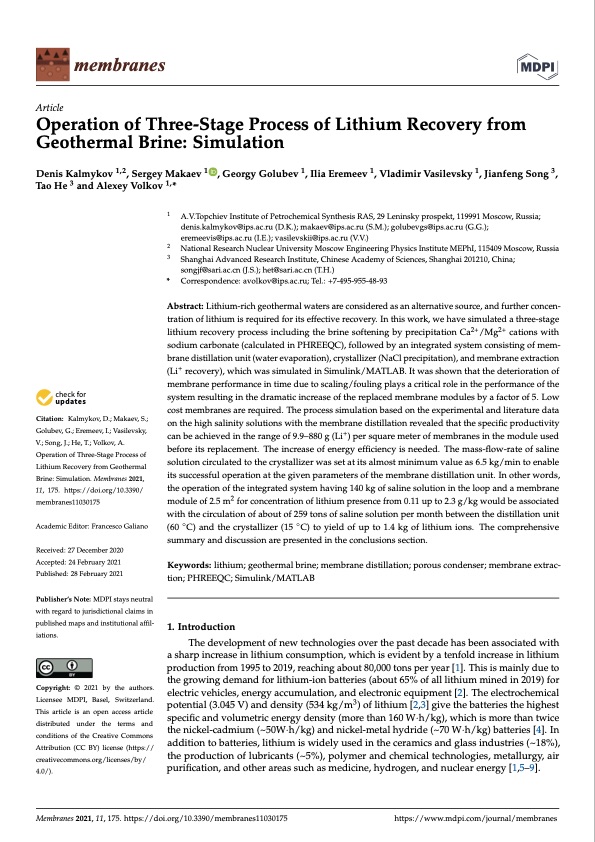
PDF Publication Title:
Text from PDF Page: 001
membranes Article Operation of Three-Stage Process of Lithium Recovery from Geothermal Brine: Simulation Denis Kalmykov 1,2, Sergey Makaev 1 , Georgy Golubev 1, Ilia Eremeev 1, Vladimir Vasilevsky 1, Jianfeng Song 3, Tao He 3 and Alexey Volkov 1,* Citation: Kalmykov,D.;Makaev,S.; Golubev, G.; Eremeev, I.; Vasilevsky, V.; Song, J.; He, T.; Volkov, A. Operation of Three-Stage Process of Lithium Recovery from Geothermal Brine: Simulation. Membranes 2021, 11, 175. https://doi.org/10.3390/ membranes11030175 Academic Editor: Francesco Galiano Received: 27 December 2020 Accepted: 24 February 2021 Published: 28 February 2021 Publisher’s Note: MDPI stays neutral with regard to jurisdictional claims in published maps and institutional affil- iations. Copyright: © 2021 by the authors. Licensee MDPI, Basel, Switzerland. This article is an open access article distributed under the terms and conditions of the Creative Commons Attribution (CC BY) license (https:// creativecommons.org/licenses/by/ 4.0/). 1 2 3 * Correspondence: avolkov@ips.ac.ru; Tel.: +7-495-955-48-93 Abstract: Lithium-rich geothermal waters are considered as an alternative source, and further concen- tration of lithium is required for its effective recovery. In this work, we have simulated a three-stage lithium recovery process including the brine softening by precipitation Ca2+/Mg2+ cations with sodium carbonate (calculated in PHREEQC), followed by an integrated system consisting of mem- brane distillation unit (water evaporation), crystallizer (NaCl precipitation), and membrane extraction (Li+ recovery), which was simulated in Simulink/MATLAB. It was shown that the deterioration of membrane performance in time due to scaling/fouling plays a critical role in the performance of the system resulting in the dramatic increase of the replaced membrane modules by a factor of 5. Low cost membranes are required. The process simulation based on the experimental and literature data on the high salinity solutions with the membrane distillation revealed that the specific productivity can be achieved in the range of 9.9–880 g (Li+) per square meter of membranes in the module used before its replacement. The increase of energy efficiency is needed. The mass-flow-rate of saline solution circulated to the crystallizer was set at its almost minimum value as 6.5 kg/min to enable its successful operation at the given parameters of the membrane distillation unit. In other words, the operation of the integrated system having 140 kg of saline solution in the loop and a membrane module of 2.5 m2 for concentration of lithium presence from 0.11 up to 2.3 g/kg would be associated with the circulation of about of 259 tons of saline solution per month between the distillation unit (60 ◦C) and the crystallizer (15 ◦C) to yield of up to 1.4 kg of lithium ions. The comprehensive summary and discussion are presented in the conclusions section. Keywords: lithium; geothermal brine; membrane distillation; porous condenser; membrane extrac- tion; PHREEQC; Simulink/MATLAB 1. Introduction The development of new technologies over the past decade has been associated with a sharp increase in lithium consumption, which is evident by a tenfold increase in lithium production from 1995 to 2019, reaching about 80,000 tons per year [1]. This is mainly due to the growing demand for lithium-ion batteries (about 65% of all lithium mined in 2019) for electric vehicles, energy accumulation, and electronic equipment [2]. The electrochemical potential (3.045 V) and density (534 kg/m3) of lithium [2,3] give the batteries the highest specific and volumetric energy density (more than 160 W·h/kg), which is more than twice the nickel-cadmium (~50W·h/kg) and nickel-metal hydride (~70 W·h/kg) batteries [4]. In addition to batteries, lithium is widely used in the ceramics and glass industries (~18%), the production of lubricants (~5%), polymer and chemical technologies, metallurgy, air purification, and other areas such as medicine, hydrogen, and nuclear energy [1,5–9]. A.V.Topchiev Institute of Petrochemical Synthesis RAS, 29 Leninsky prospekt, 119991 Moscow, Russia; denis.kalmykov@ips.ac.ru (D.K.); makaev@ips.ac.ru (S.M.); golubevgs@ips.ac.ru (G.G.); eremeevis@ips.ac.ru (I.E.); vasilevskii@ips.ac.ru (V.V.) National Research Nuclear University Moscow Engineering Physics Institute MEPhI, 115409 Moscow, Russia Shanghai Advanced Research Institute, Chinese Academy of Sciences, Shanghai 201210, China; songjf@sari.ac.cn (J.S.); het@sari.ac.cn (T.H.) Membranes 2021, 11, 175. https://doi.org/10.3390/membranes11030175 https://www.mdpi.com/journal/membranesPDF Image | Process of Lithium Recovery from Geothermal Brine

PDF Search Title:
Process of Lithium Recovery from Geothermal BrineOriginal File Name Searched:
membranes-11-00175-v2.pdfDIY PDF Search: Google It | Yahoo | Bing
Product and Development Focus for Infinity Turbine
ORC Waste Heat Turbine and ORC System Build Plans: All turbine plans are $10,000 each. This allows you to build a system and then consider licensing for production after you have completed and tested a unit.Redox Flow Battery Technology: With the advent of the new USA tax credits for producing and selling batteries ($35/kW) we are focussing on a simple flow battery using shipping containers as the modular electrolyte storage units with tax credits up to $140,000 per system. Our main focus is on the salt battery. This battery can be used for both thermal and electrical storage applications. We call it the Cogeneration Battery or Cogen Battery. One project is converting salt (brine) based water conditioners to simultaneously produce power. In addition, there are many opportunities to extract Lithium from brine (salt lakes, groundwater, and producer water).Salt water or brine are huge sources for lithium. Most of the worlds lithium is acquired from a brine source. It's even in seawater in a low concentration. Brine is also a byproduct of huge powerplants, which can now use that as an electrolyte and a huge flow battery (which allows storage at the source).We welcome any business and equipment inquiries, as well as licensing our turbines for manufacturing.| CONTACT TEL: 608-238-6001 Email: greg@infinityturbine.com | RSS | AMP |